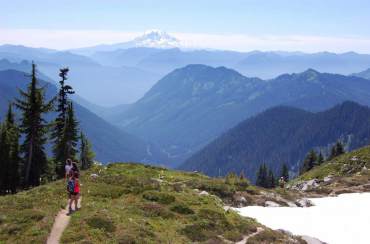
It’s no secret (or surprise) that more and more people are heading to the trails for their regular exercise, whether walking/hiking or running. Last month, we talked about basic tips that will make your trail experience more enjoyable and safe. In part 2, we’ll review some trail-specific technical tips that will make adjusting to the trails less painful and more enjoyable for you and others.
Trail Specific Tips and Guidelines
Before you head out for a hike or run on the trails, it’s important to know some guidelines for time on the unique terrain that trails offer. These five guidelines will help protect you from accidents and frustrations along the way.
1. Watch your step.
Perhaps more literally than anywhere, you do have to watch your steps carefully. In general, it’s helpful to keep your eyes on the path for the 5-10 feet in front of you, staying alert to upcoming obstacles, terrain changes or other surprises.
Trail paths are constantly changing and the scenery is often distracting in its beauty. It takes some intention to learn the balance in watching your steps and enjoying the surroundings.
2. Go over, not onto.
Fallen trees, stepping stones through running water and large roots are common sites on any trail you may find yourself on. While it’s often tempting to step onto obstacles in the path’s way, it’s a good rule to step over (or climb under) instead.
Rotted stumps and slippery stones can be disguised as seemingly sturdy rocks and logs. Taking the extra seconds to place your feet on sturdy ground can save you from painful stumbles and scrapes — or worse!
3. Even when running, walking is encouraged.
There are many similarities between road and trail running, but just as many differences. One important difference is the accepted and encouraged practice of walking up hills when trail running.
The extra energy expenditure required to run is rarely made up for in time and often leads to exhaustion and slower overall times. Even accomplished, veteran trail runners can usually be seen power-walking the hills.
4. Road miles do not equal trail miles.
A very important principle of exercising on the trails is understanding that a 5-mile hike or run on trail terrain typically requires (and burns) more energy than the same 5 miles on a track or road.
This is an important concept to remember, as it has implications for refueling with food and water more frequently, as well as understanding why that “short” trail hike seems to have you exponentially more sore than your usual daily walk around the neighborhood.
5. Leave no trace.
It doesn’t take much exposure to the trails before you hear this phrase. Part of the benefit of time on the trails is the peaceful nature and feeling like we are part of something beautiful and bigger than ourselves.
Out of respect for this, and for the countless people (typically volunteers) who give their time and money to maintain the trails, it is considered a golden rule to leave nothing on the trails that you brought with you.
Plastic bags or containers can easily be slipped in pockets to carry out food packaging, wrappers or other trash that you may produce, particularly during longer hikes or runs. If you see litter that shouldn’t be there, please pick it up and pack it out! You’ll be doing your part to keep the trails clean for everyone to enjoy.
By keeping these tips in mind, you’ll be on your way to having a beautiful, peaceful, safe and fun experience. See you on the trails!























Comments